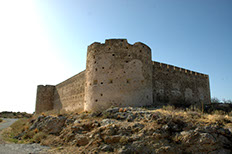
Sunday July 8
Aptera Archaeological Site & Tombs of the Venizelos Family
10:00 – Pick up from Minoa Palace
If you require pick up from another hotel please let the Conference Management Assistant, Mr George Sarrigeorgiou, know during registration.
10:00 – 14:00 – Sightseeing Aptera Archaeological Site
The archaeological site of Aptera, which was the most powerful city of western Crete during Minoan times, is located 15 km from the city of Chania, Crete, just south of Souda Bay, on a hill above the national road that connects Chania with the city of Rethymnon.
The findings of the archaeological excavations, still coming to light, fill the history puzzle of this ancient city. They give details about the settlement’s composition, the city’s architecture, the religion and habits of Apterean residents who were keen archers.
Although the earliest mention of the Aptera is found as a-pa-ta-wa on the Linear script B tablets of Knossos, which dated to the 14th-13th century BC, the currently rich findings of the excavations indicate that the hill was inhabited from the 8th century BC until the 7th century AD, when it was abandoned due to a strong earthquake and because of the attacks by the Saracen Arab pirates. Learn the history of the most important and most commercial ancient city-state of western Crete, as mentioned in the historical scrapbook issued by the 25th Ephorate of Prehistory and Classical Antiquities.
At the archaeological site, you will be able to admire findings of all periods of inhabitation of this city-state, everything that could not be transferred to the Archaeological Museum of Chania. Indicatively,
1. Tombs of the 8th, 7th, 4th, 3rd century BC and chiseled chamber tombs of Crete’s Roman period.
2. Ruins of temples of the 8th century BC, of the 5th century BC and the 1st century BC.
3. The walls of the ancient city, which is 3.480 meters long, dating back to the 4th century BC.
4. A theatre that belongs to the Roman phase. However, traces of the previous phase of the Hellenistic times have been found.
5. Ruins of a villa with peristyle yard, of the early years of Roman rule and built on the standards of the Hellenistic period.
6. Unexpectedly high Roman cisterns and parts of public and private baths.
7. Buildings of the Byzantine Period.
Human presence on the hill also continues in the subsequent years.
At the midpoint of the hill is perhaps the city’s market, which was founded by the Monastery of Agios Ioannis Theologos, and which was constructed using building materials of the ancient city.
Finally, the fortress shown on a lower hill in the Northeast 9, belongs in the period of the Turkish occupation in Crete. Its name is “Koules of Aptera” or “Fortress of Sousbasi,” and the Turks in the context of a broader fortress construction program, to counter the Cretan revolutions, built it.
Tombs of the Venizelos Family
Venizelos graves, the graves of Eleftherios Venizelos and Sofoklis Venizelos, are situated in an excellent location of the hill of Prophet Elias, in Akrotiri peninsula, just 5 km east from the city of Chania, Crete.
Both Venizelos graves, next to each other, are in a beautiful park created with gardens, paved paths, stairs, terraces and benches under the shade of pine trees, but what gives awesome beauty to this place, are the panoramic views in the sea area, the city of Chania and the whole region.
Just a few meters away from the Venizelos graves you can see: The historic church of Prophet Elias, which dates back to the early 16th century, featuring the Venetian architecture style. There is also the statue of the Cretan hero Spiros Kagialedakis who raised the flag by making his own body a flagstaff and was killed by the firings of the ships of the “Great Powers” of that time, during the revolution of Akrotiti in 1897.
14:00 – 17:30 –Falasarna for lunch, swimming and sightseeing
Falasarna (sometimes written as Phalasarna) is located on the West coast of Crete and, similarly to Elafonisi is popular with day trippers because of its stunning beaches and clear turquoise blue sea.
It consists of several sandy beaches of various lengths, all facing the West (which makes it a wonderful place to watch the sunset from). The sea is generally very clean and with lovely colours because of the sandy bottom. If you are interested in archaeology you can also visit the remains of a fortified Hellenistic harbour. Because of a sudden uplift of the West of Crete 1500 years ago the harbour is now located inland.
Because there is a good area of flat fertile land running along the coast, a lot of greenhouses have been erected in the last 20 years or so, and Falasarna, especially seen from above as you drive down the hill, is not as beautiful as it once was. But when you are on the beach you won’t notice them anymore.
Monday July 9
Boat trip to Gramvousa and Balos
TBA – Pick up from Minoa Palace
If you require pick up from another hotel please let the Conference Management Assistant, Mr George Sarrigeorgiou, know during registration.
Transport from the hotel to Kissamos Port
The boat departs at 10.50 o’clock from Kissamos Port.
The ancient shipyard of Tarsanas and the geological phenomenon of land elevation of Crete, which is rising out of the sea in the west and sinking in the east, can be seen during the 1-hour cruise.
A refreshing dive into the crystal clear waters of the Balos Lagoon, our first destination, will give you something to remember for a long time. Your three-hour stay in this area, protected for its beauty by the European Union, is enough time to get a super suntan.
The small harbour of Gramvoussa Island, which used to be the shelter of the Cretan Pirates, is our next destination.
The Venetian castle and the countless battles that took place there during the liberation war of the Cretans against the Turks, the pirate myths and stories about hidden treasures waiting for you to discover them, will make your heart beat faster during your one and a half hour stay.
The boat departs at 17:00 for Kissamos harbour. A bus will take you back to your hotel.





